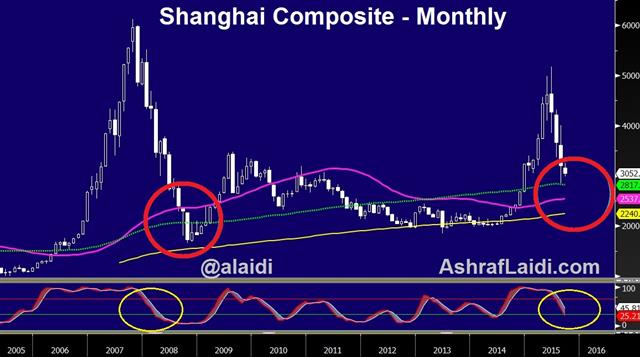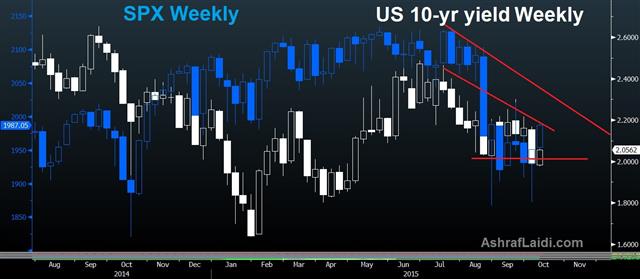Intraday Market Thoughts Archives
Displaying results for week of Oct 04, 2015Another Way to Look at the Dollar
The US dollar is inextricably linked to the Fed, or is it? The greenback was the laggard on Thursday after the FOMC Minutes, but we look at how ignoring the whims of the Fed paints a compelling underlying picture of the dollar. Australian home loans highlight a quiet end to Asia-Pacific week. Ashraf's Premium Insights service went short on a currency pair, with a 73% winning record since 2011. The trade has been filled and is now in progress.

What if the Fed isn't the major driver of the US dollar? Every report we read is hyper-analytical of every word from anyone at the Fed. The narrative of September in markets was will-they-hike-or-won't-they. The thing is, it's impossible to explain market moves since August with such a focus on the Fed.
A better narrative is this: 1) The US economy isn't as robust as believed or hoped. It's a 2% economy not a 3% economy and recent data underscores it with strong dollar headwinds still in the pipeline. 2) Emerging market growth has stumbled, especially in Latin America. 3) China's slowdown is evident but not its extent as it's such an opaque economy to the extent of triggering more fear/risk aversion than would normally have been justified.
The US dollar was already on its way to topping before the events of August/September. Ashraf had mentioned it two months ago on Twitter and on this website (see tweet above) when it was popular to predict a higher USD and a Fed rate hike. Manufacturing and capex numbers were softening but when China revalued it created fear elsewhere and a flight into the safety of US dollars. That was directly competing with the softer US outlook/Fed and the push-and-pull sparked volatility, uncertainty and even more risk aversion. A second wave hit around quarter end on window dressing.
Now the smoke is clearing on the emerging market confusion. Growth has slowed but it's not as bad as feared and China has plenty of ammunition to stimulate its economy. That leaves the theme of less-robust US growth and the safe haven flows into the US dollar will slowly reverse and that will be what leads to the kind of steady US dollar selling we saw in New York trading today.
The Australian dollar is especially well-positioned to benefit. We wrote about how October is the best month seasonally for AUD and it's climbed for seven consecutive days. Impressively, today it erased an earlier loss to close near the highs. In fact, today's Premium trade is related to a commodity currency.
The focus will remain on AUD and sharpen at 0030 GMT with the release of August home loan data. The consensus is for a 4.7% m/m rise.
| Act | Exp | Prev | GMT |
|---|---|---|---|
| Home Loans (AUG) | |||
| 5.0% | 0.3% | Oct 09 1:00 | |
أشرف العايدي في قناة العربية
Chinese Stocks Set to Rally in Return
In the near-term the focus is on China as it returns from an extended holiday. The kiwi was the top performer on Wednesday while the Swiss franc lagged. Japan also releases top-tier data in the hours ahead. One of the two existing Premium GBP trades was adjusted ahead of tomorrow's BoE decision.

China has been on holiday for five days and that covers the latest leg of global equity market strength. Foreign-listed Chinese ETFs are up nearly 10% since the Shanghai Composite closed on September 30.
The spike should be priced in but the headlines could spill over and spark a bit of optimism elsewhere. The market has been digesting a steady stream of good news from the stock market as the S&P 500 climbed for the sixth time in seven days.
The Australian dollar also climbed to make it six straight days of gains. The Canadian dollar had joined it earlier in the session but reversed lower alongside oil after US weekly oil inventories were unexpectedly large.
Again, we reiterate USDJPY's inability to rally despite the latest bump in risk sentiment, which highlights the fact that a dovish Fed is an integral component of the rally. However, December Fed fund futures have been ticking higher and are at 40% -- the best level since non-farm payrolls.
The Bank of Japan is the flipside of the USD/JPY equation and hopes for more BOJ faded after yesterday's meeting. Kuroda remained confident in the inflation forecast and didn't make a case for easing when officials meet again on Oct 30. But market participants have a good memory and recall that last year's BOJ QE was a surprise.
Kuroda, however, may have tried to overtly dampen speculation as he highlighted differences between last year's economy and the current outlook. At the time, measures of inflation were falling and this year they're rising, he noted.
Economic data will continue to be scrutinized. At 2350 GMT the August machine orders report is due and expected up 2.3% m/m. At the same time current account data is due.
| Act | Exp | Prev | GMT |
|---|---|---|---|
| Current Account n.s.a. (AUG) | |||
| ¥1,221.0B | ¥1,808.6B | Oct 07 23:50 | |
Commodity FX Climb, BOJ Next
Is the best sign of the abatement in fears about the global economy seen via the recent non-stop rally in commodity currencies? Or, is it a manifestation of USD weakness resulting from a substitution of higher yielding currencies at a time when the much talked-about Fed hike is pushed back further in the unknown horizon? It extended Tuesday as the Australian dollar led the way while the US dollar lagged. The BOJ meeting due up next , with the possibility that China releases itsr latest FX resereves data even as markets are shut for the final day of National Day holidays. Ashraf issued a 33-minute video for Premium subscribers highlighting the similarities and differences in the current equities bounce with the developments of 2011, 2008 and 2000.

The Australian, and Canadian dollars climbed for the fifth consecutive days. AUD rallied the most in four weeks as a result of the RBA, which held a neutral stance rather than shifting to a more dovish bias. The Canadian dollar was lifted by oil, which gained 5% on better demand forecasts and tighter inventory data. WTI crude is now testing the Aug 30 high of $49.44 in what's a key level to watch for CAD traders.
We are cautious that the five-day commodity currency rally has coincided with a five-day Chinese holiday. In addition, note that USD/CAD has only rallied in six consecutive days twice since 2009 and never for seven straight days. The most-recent six day rally was in July 2013. The pair is nearing the post-FOMC spike low of 1.3010.
In the hours ahead, commodity currencies will vacate the spotlight to the yen as the BOJ meets. The decision has no fixed time but is usually in the 0230 GMT-0330 GMT range.
The bigger BOJ meeting comes on Oct 30 and that's a date that some analysts have signalled as the start of yet-another round of QE because it also includes updated economic forecasts. Abe recently talked about launching Abenomics 2.0 and yen weakness has been a key part of his platform but other signals have suggested the BOJ is very reluctant to easy further.
Ashraf Live Webinar Wednesday w/ FXStreet
Ashraf's Live Webinar tomorrow with FXStreet starts at 10:15 ET, 14:15 GMT, 15:15 BST. The interview will be conducted with Dale Pinkert of FXStreet.
USD/JPY Hesitant to Embrace the Upside
A sharp rally in stock markets and heavy selling in bonds only led to minor USD/JPY buying in yet-another sign of indecision in the pair. Overall, FX moves were light in US trading as the kiwi led the way on the day while JPY lagged. The RBA decision is up next. Ashraf's Premium Insights identified a rare Head-&-Shoulder formation, backed by supporting fundamentals, leading to a new Premium trade.

The US September ISM non-manufacturing index was the economic data highlight of the day and it flashed mixed signals. The overall reading of 56.9 was worse than the 57.5 expected and 59.0 prior but the internals raise other questions. New orders were weak, falling to 56.7 from 63.4 in a sign that businesses remain reluctant to invest, posting the biggest decline since 2008. More surprising was employment, which rose to 58.3 from 56.0 and flouted Friday's soft nonfarm payrolls report.
Overall, evidence continues to show the US economy slogging along in the 2.0% to 2.5% but it's been stuck in for the past five years. Hopes for an acceleration or wage gains will slowly fade as the effects of hawkish Fed talk, a strong US dollar and slower global growth weigh.
That helps to explain why USD/JPY has been reluctant to rally. It remains near the midpoint of its 6-week range despite talk the BoJ is edging closer to easing. Ultimately, that range may be the most-important chart in FX and when it breaks, it will reignite high volatility in currency market. Unless the US 10-year yield recovers and closes the week above the 200-DMA of 2.12%, USDJPY is unlikely to move beyond 121.00. The BoJ meets on Wednesday and is unlikely to raise QE due to the already notable developments in wages, corporate profits and the cheaper yen. There is, however, chatter of action at the next meeting, once the international focus of G20 meetings is behind us. A rate cut or a higher QE could be in the works if USDJPY drops below 118.00 by then.
The spot to look for volatility in the short term is the Australian dollar. The RBA decision is at 0330 GMT but first the August trade balance report is due at 0030 GMT. The consensus is for a 2.4B deficit, which would be the best reading since March but still a headwind for Australian growth.
The RBA isn't at all expected to move from its 2.00% rate but Stevens could signal action later in the year. We're also curious to hear any comments about the Chinese economy.
| Act | Exp | Prev | GMT |
|---|---|---|---|
| ISM Non-Manufacutring Composite (SEP) | |||
| 56.9 | 57.5 | 59.0 | Oct 05 14:00 |
| Trade Balance (AUG) | |||
| $-45.50B | $-41.86B | Oct 06 12:30 | |
| ANZ Job Advertisements (SEP) (m/m) | |||
| 3.9% | 1.3% | Oct 05 0:30 | |
What the TPP Means for FX
Markets opened the new week relatively flat. Japanese wage inflation data and the services PMI are due up later. China remains on holiday. A deal on the Trans-Pacific Partnership is expected to be announced today, we look at what it means as well as at the latest CFTC data.
Early in the week the focus is on Australia with the RBA meeting Oct 6. There is little talk of a rate cut but officials could signal the potential for further easing later in the year. Economic data was mixed with the AiG service sector index falling to 52.3 from 55.6%. That was balanced by TD Securities inflation expectations rising to 1.9% from 1.7%.
AUD/USD is up 5 pips at 0.7049.
A central bank that's more likely to act this month is the BOJ so every Japanese data point will be scrutinized. At 0130 GMT it's the August Japanese labor cash earnings report. It's expected to rise just 0.6% y/y, down from a 0.9% rise the month before and further away from Japan's inflation target. That will be followed 5 minutes later but Japan's services PMI from Nikkei. The prior reading was 53.7. Ashraf's latest take on the next BoJ meeting is in the current USDJPY Premium trade.
What you need to know about the Trans-Pacific Partnership
It's a 12-nation free trade-type deal aimed at diminishing trade barriers. The participating countries are the United States, Chile, Singapore, Australia, Peru, Vietnam, Malaysia, Mexico, Japan, Canada and Brunei. It has been negotiated in secret. If a deal is struck today the text will be released and national parliaments will have a year to ratify the agreement.The TPP could also further extend the US trade deficit with Japan once the US lifts hefty tariffs on cars and trucks. US winners are likely to be big oil and chemicals seeking to expand investments in Malaysia.
Markets will closely watch details on agriculture, manufacturing, intellectual property and pharmaceuticals. Companies in those industries may react to the details, but currencies could also shift if national industries – like New Zealand dairy – are perceived to be under threat, or in a position to expand.
Commitments of Traders
Speculative net futures trader positions as of the close on Tuesday. Net short denoted by - long by +.EUR -88K vs -81K prior JPY -22K vs -24K prior GBP -2K vs +1K prior AUD -49K vs -53K prior CAD -42K vs -38K prior CHF -3K vs -2K prior
Last week, US dollar net longs fell to their lowest in a year but they bounced back slightly this week, mainly on yen and commodity currency selling. With the sharp deterioration in Fed hike hopes, the US dollar remains vulnerable on the downside.
| Act | Exp | Prev | GMT |
|---|---|---|---|
| Markit PMI Composite (SEP) | |||
| 55.3 | Oct 05 13:45 | ||
| Markit Services PMI (SEP) | |||
| 55.6 | Oct 05 13:45 | ||
| ISM Non-Manufacturing PMI (SEP) | |||
| 58 | 59 | Oct 05 14:00 | |
| TD Securities Inflation (SEP) (m/m) | |||
| 0.3% | 0.1% | Oct 04 23:30 | |
| TD Securities Inflation (SEP) (y/y) | |||
| 1.9% | 1.7% | Oct 04 23:30 | |
| Labor Cash Earnings (AUG) (y/y) | |||
| 0.9% | Oct 05 1:30 | ||
My June 15 Warning. Now what?
On June 15, I wrote an IMT (unpaid part of this website), pointing out to the 40-month cycle in USDJPY, implying that USDJPY has already seen the peak. Since then, the pair has fallen by more than 400 pips in at least three occasions. Yes, it has also rebounded few times, but selling the bounce has proven more rewarding than buying the dips. Here is the JUNE 15 CHART. Some may say the problem with such long-term cyclical analysis is timing. That's where the role of momentum charts comes in to back up our Premium trades, which we use to confirm and update our central thesis with the rationale part of each trade. The addition of 1-2 per week videos for our Premium subscribers has been instrumental in fitting a lot of ideas & saving me writing. The last two Premium trades in USDJPY produced more than 200 pips each. Friday's market reversal comprised a crucial development to our central thesis. The next 3 weeks will witness a bloody battle bwteen bulls and bears. All of this will be broken down in this week's Premium trades, charts & videos. Good luck & be careful.








